Epitope binning immunoassays using surface plasmon resonance (SPR) can and should be deployed in the development of new potential drug candidates. This article discusses how SPR is used to characterize closely related “bins” of mAbs targeting the same epitope of the target protein and how the selection process is used to develop new vaccines, therapeutic antibodies, and diagnostic tools.
Where does epitope binning fit in the antibody development process?
Therapeutic monoclonal antibodies (mAb) are a large and growing part of the biopharmaceutical market, accounting for over 50% of therapeutic protein sales. It is critical during the development of new vaccines, therapeutic Abs, and diagnostic tools that mAbs with the appropriate affinity, specificity, and biophysical properties are selected.
Epitope binning is used to characterize the binding of mAbs to a target protein, the antigen. In epitope binning, mAbs specific to the same target protein are tested pairwise against all mAbs in a set to assess whether they block one another’s binding to a specific site of the antigen or not. The mAbs that block binding to the same epitope are “binned” together.
Early stage Ab drug development efforts often generate many leads, which means that it is critical to select the best candidates for further investigation. mAbs within the same bin often function similarly, so epitope bins can narrow down the choices to fewer candidates for investigators to choose from. In addition, although the Abs within a bin bind to the same antigen, they may have different mechanisms of action, which is critical for treating some types of cancers and infectious diseases. Epitope diversity is also important to broaden intellectual property (IP) protection, i.e., see review of current best practices for the use of epitope information.
What are the analytical strategies for better informed antibody selection?
Bioengineering has developed to where scientists can now engineer new types of antibodies against increasingly complex targets or disease pathways. Abs have evolved from simpler mAbs to more complex biological entities, e.g., BITES, multispecifics, conjugates, etc. This is increasing the analytical burden and driving a need for more advanced analytical techniques. To meet these challenges biosensors have been incorporated into the drug discovery workflow. Since the early 1990s, biosensors based on surface plasmon resonance (SPR) have been employed for epitope binning.
Epitope binning using conventional ELISAs, and Radioimmunoassays (RIAs) require significant amounts of time to purify Abs and develop labelling methods. Epitope binning assays using label-free biosensors allow for a candidate molecule to be tested at a relatively low cost and high throughput in an automated manner, allowing for efficient drug candidate optimization and identification of Ab pairs.
Surface plasmon resonance (SPR) assay setup
There are a range of possible formats for easy setup and running of an epitope binning assay via SPR. Common to all assay formats, and consistent with ELISA based approaches, are the use of an antigen and two Abs that bind to the antigen in question. Biacore 8K and Biacore 8K+ combined with Biacore Insight Evaluation Software and utilizing the new Biacore Insight Epitope Binning Extension, support three generic assay formats, sandwich, premix, and tandem (Fig 1), for epitope binning as predefined method protocols.

Fig 1. Schematic overview of the set-up for pairwise epitope binning using a) sandwich assay, b) premix assay, and c) tandem assay. All three assay formats involve attachment of the first Ab (a, b) or the antigen (c) to the sensor chip surface followed by subsequent injections of either the antigen and second Ab in sequence (a) or premixed (b), or the two Abs (c).
In the sandwich assay shown in Figure 2, the first Ab is captured or covalently attached to the surface of the sensor. The antigen is then injected and binds to the first Ab. This is followed by injection of the second Ab. The sensorgram in Figure 3, from 0 to 120 seconds (s), shows the antigen binding to the immobilized first Ab. At 120 s, the second Ab is injected. The second Ab either binds to the first antigen resulting in a “sandwich” binding response (blue) or is blocked from binding to the antigen by the first Ab (orange). If the second Ab can bind to the antigen in the presence of the first Ab, they have different epitopes and therefore belong to different bins. If the second Ab is not able to bind to the Ab, both Abs belong to the same bin.

Fig 2. Injection order of a sandwich assay.
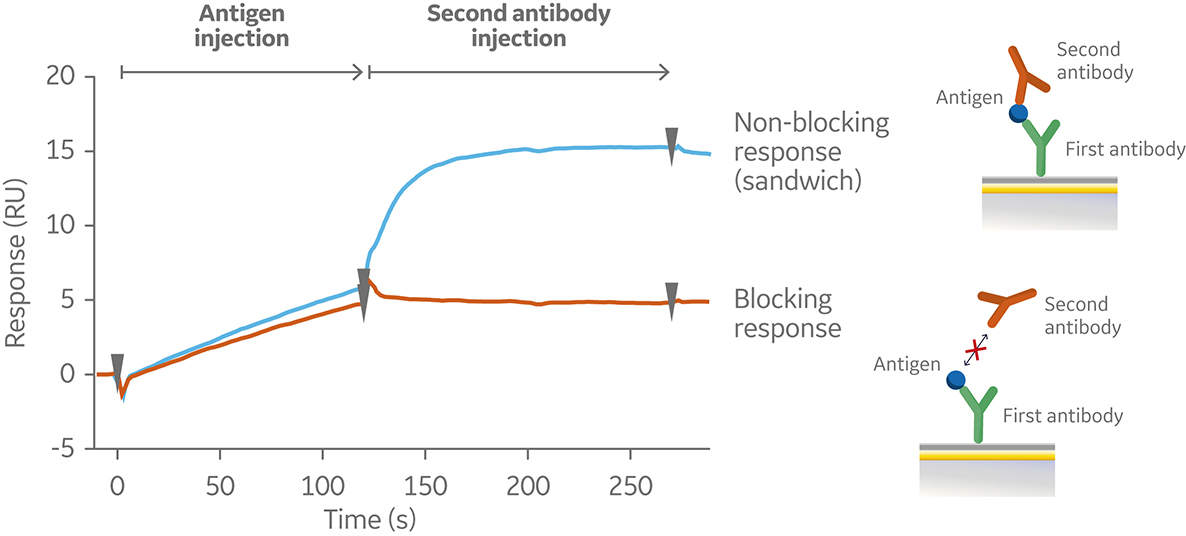
Fig 3. Sensorgram illustrating the outcome of a sandwich assay with a non-blocking (blue) and blocking response (orange) from pairwise testing of two Abs to an antigen. The first Ab was pre-immobilized to the sensor chip surface (not shown).

Fig 4. Injection order of a premix assay setup.
Similar to the sandwich assay, the first Ab in the premix assay is captured or covalently coupled to the surface of the sensor chip. However, in the premix assay the second Ab and antigen are mixed outside of the instrument, using saturating conditions, prior to injection (Fig 4). The Ab and the antigen are then injected into the instrument. Figure 5 shows a sensorgram from a premix assay.
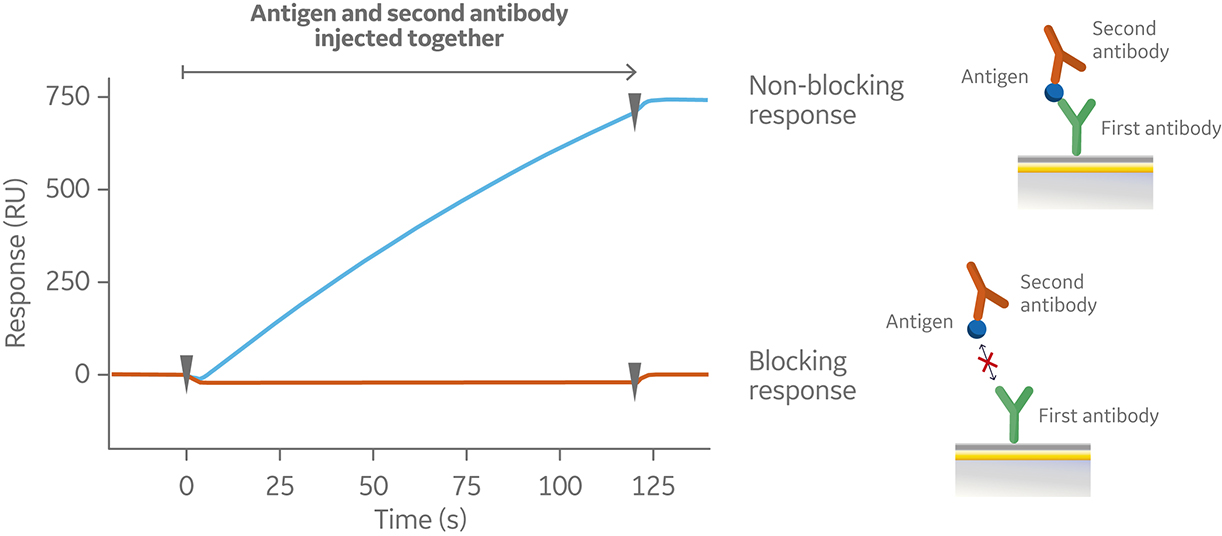
Fig 5. Sensorgram from a premix assay, illustrating a non-blocking (blue) and blocking interaction (orange) as a result of injection of premixed antigen and second Ab over a pre-immobilized first Ab (not shown in sensorgram).
In a tandem assay, the antigen is captured or covalently coupled to the sensor surface. The first Ab is then injected at saturating antigen binding conditions, followed by injection of the second Ab. A typically sensorgram for a tandem assay is shown in Figure 6.
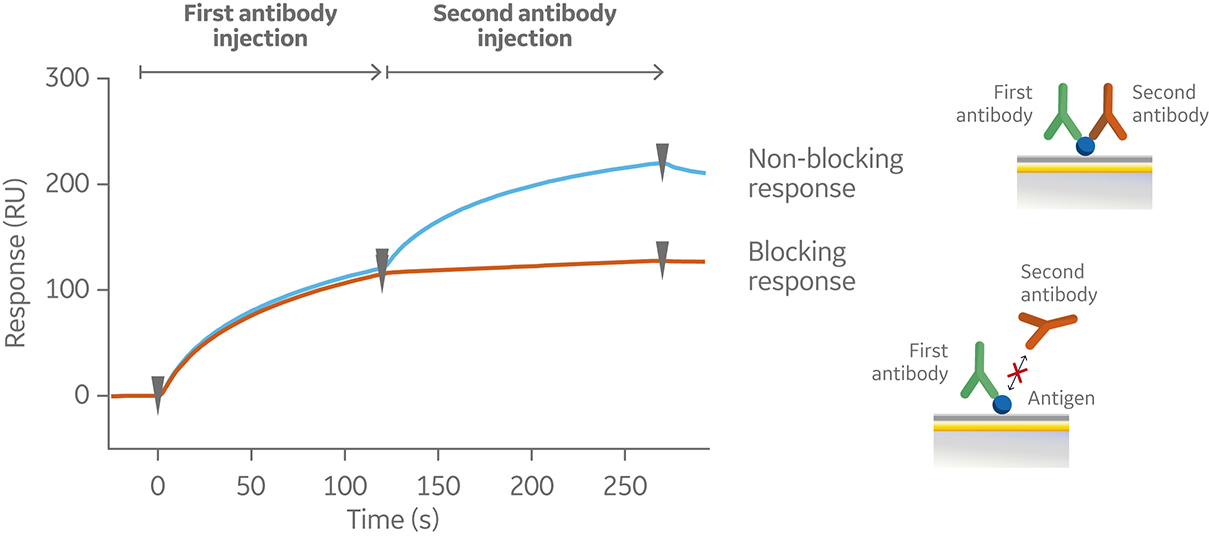
Fig 6. Sensorgram from a tandem assay, showing a non-blocking (blue) and blocking (orange) response following subsequent injections of two Abs against a pre-immobilized antigen (not shown in the sensorgram).
The different assay formats are complementary but have different advantages and disadvantages. A sandwich assay has a rather straightforward assay set up when regeneration conditions are known. The premix assay format is compatible with multivalent antigens and is often used if results from a sandwich assay need to be confirmed. However, the concentration of premix antibody must be in large excess over antigen concentration.
The tandem assay format is conceptually simple and also compatible with more complex, multivalent antigen targets. It requires low amounts of antigen when immobilized and the first Ab has to saturate all specific binding sites.
Given the latest advances of Biacore systems, the choice of assay design is defined by the molecules and reagents under investigation, not by technology ability.
Automating your epitope binning to find sweet spot bins
Within a given assay format, runs may be performed in a symmetrical or asymmetrical fashion. For symmetrical assays, every pairwise variation of antibodies is tested against each other by switching the order in which the Abs bind to their antigen. This approach may give a clearer outcome but for larger matrixes, symmetrical runs will result in a considerable amount of data in a short amount of time. This is because the number of interactions required scales geometrically with the number of Abs in the test panel. For example, a 20 × 20 epitope binning analysis will generate 400 interactions (Fig 7).
Alternatively, asymmetric assays can be performed against a chosen number of Abs representative of different epitope bins or for example already commercialized drugs, whose bins should be avoided if new drugs are being developed. For example, an 8 × 200 assay would efficiently reduce the number of interactions to be followed up in a symmetrical run. A way to increase confidence in data for both symmetrical and asymmetrical runs is to compare results from an alternative assay format (for instance sandwich assay followed by a premix assay).
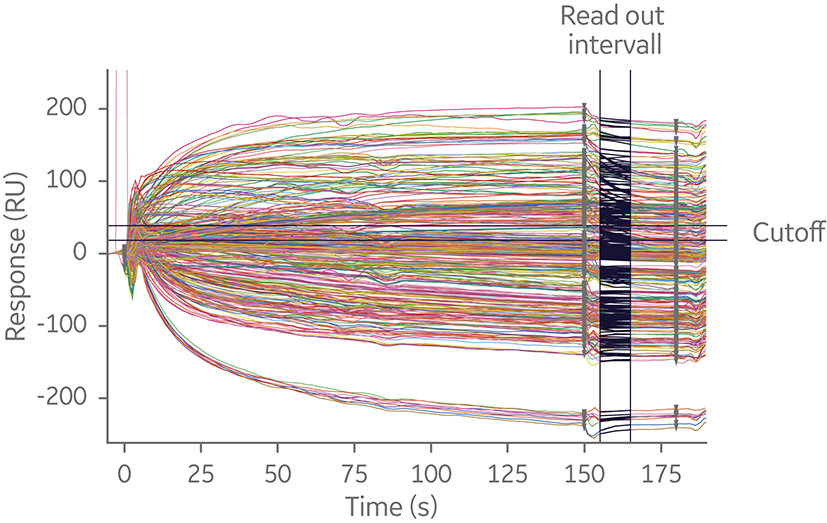
Fig 7. Sensorgram overlay of sandwich 20 × 20 SPR assay. The experiment utilized a capture antibody assay format to minimize time spent on assay development. Independent of where in the screening process epitope binning is performed; analyzing a large number of interactions is time-consuming.
Consequently, it is necessary to have tools to quickly interpret data by illustrating and evaluating epitope bins. Two ways to visualize data from epitope binning assays are heat maps and bin wheels, as shown in Figure 8. The heat map used in Biacore Insight Epitope Binning Extension presents an overview of the blocking (red), non-blocking (white), and uncertain Ab pairs (yellow). Thus, the heat map serves as a guide of uncertain results that need closer inspection of the data. The bin wheel visualizes all detected bins in the current study by assigning Abs with exactly the same binning pattern the same color. Furthermore, Abs with shared but not completely overlapping binning patterns are colored differently but aligned next to each other in the bin. In addition, uni- and bi-directional behaviors between different bins are marked with arrows. Taken together, the bin wheel provides a comprehensive graphical representation of the results.
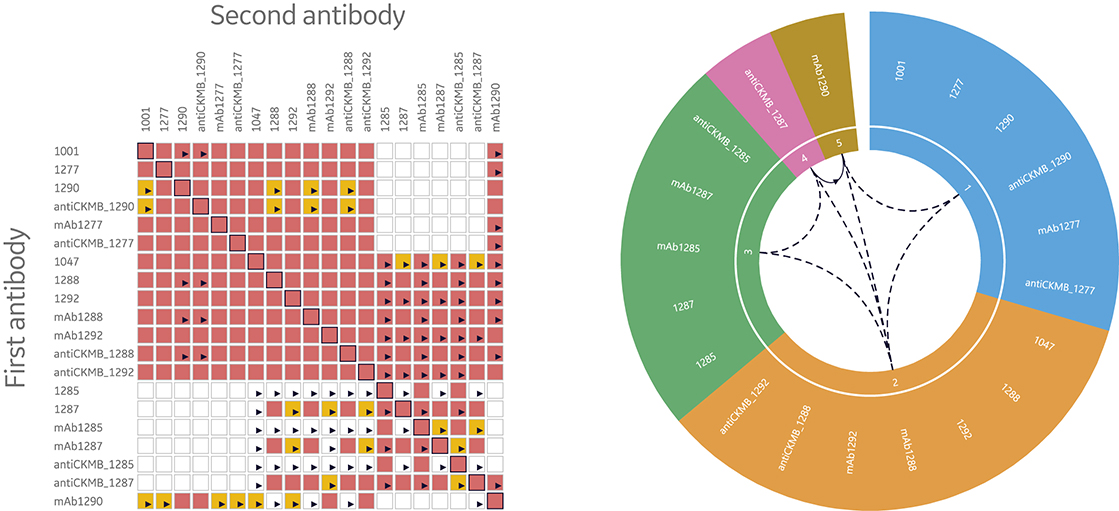
Fig 8. Heat maps and bin wheels are central features in the streamlined evaluation support provided in Biacore Insight Epitope Binning Extension making data evaluation more efficient through the automatic analysis and visualization of bins for Biacore 8K series and Biacore T200 systems.
Overcome unstable binding of antigen to primary Ab
A common issue for sandwich and tandem assays in epitope binning, irrespective of technique used (label free vs ELISA), is low affinity of binding between the antigen and the first Ab. This results in dissociation of the antigen during wash steps/cycles, and subsequent underestimation of binding level of the second Ab, which leads to assignment of an Ab to the same bin where in fact it is not blocked at all.
To overcome this problem while using Biacore systems, antigen and the second Ab may be injected using the Dual command. It injects the two solutions in sequence with no intermediate washing steps. Thus, the dissociation of antigen before the secondary Ab is injected will be minimized. This is one of the advantages of Biacore SPR systems over conventional technologies, such as ELISAs, for binning studies.
The Dual command allows the interpretation of binning data even for fast dissociating antigen, as it minimizes the dissociation of antigen before the second Ab is injected.
Figure 9 shows the sensorgrams from an 8 × 1 sandwich assay using Biacore 8K. Eight Abs were pre-immobilized in channels 1 through 8, respectively, followed by one injection of antigen and one injection of second Ab. The assay was performed with separate injections (left) and then repeated using the Dual injection command (right). One of the eight pre-immobilized Abs displayed low affinity to the antigen.

Fig 9. Sensorgram (left) shows a weak-binding antigen to the first Ab, which may lead to underestimation of second Ab binding level. The sensorgram on the right shows the same sandwich assays set up using the Dual command. This injects the two solutions in sequence with no intermediate washing steps minimizing the dissociation of the antigen before the secondary Ab is injected.
Conclusion
A critical part of drug discovery and development efforts is finding and focusing on the most promising candidates. Epitope binning analysis using SPR systems gives investigators functionality information on therapeutic antibodies earlier in the development process. Epitope diversity is also important to broaden IP protection. However, the largest challenge associated with epitope binning analysis is meaningful evaluation of large data sets.
Biacore 8K and Biacore 8K+ combined with Biacore Insight Epitope Binning Extension provides built in support and automated analysis tools for the rapid evaluation of data from the most commonly used epitope binning assay formats. This allows investigators to rapidly prioritize samples for further characterization studies and reach conclusions with confidence.
- Biacore reference list; a selection of publications presenting where and how SPR technology and Biacore systems have been applied